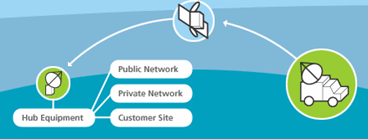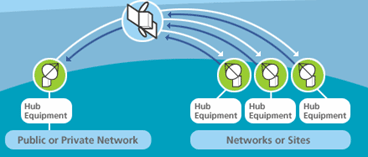Satellite Basics
1. Benefits of satellite communications
A. How do satellites deliver vital communications around the world?
Because of their universal and multi-point nature, satellite-based solutions can provide a flexible and cost-effective answer to support:
- Fixed or wireless voice and data communications
- Enterprise networking
- Financial transactions
- Internet linkages
- Satellite video transmission and distribution networks
In every case, Telcentric solutions provide for the delivery of vital information, news, sports and entertainment to every corner of the globe, no matter how remote.

B: What are the key benefits of satellites?
Satellite communications have distinct benefits over terrestrial alternatives:
- UNIVERSAL: Satellite communications are available virtually everywhere. A small constellation of satellites can cover the Earth's entire surface. And even the reach of a single satellite is far more extensive than what any terrestrial network can achieve.
- VERSATILE: Satellites can support all of today's communications needs - transactional and multimedia applications, video, voice, cellular networks, entertainment and breaking news.
- Bring broadband to the last mile of residences and businesses.
- Overcome regulatory issues that make alternative carriers dependent on incumbents.
- Deliver a communications infrastructure to areas where terrestrial alternatives are unavailable, unreliable or simply too expensive.
- RELIABLE: Satellite is a proven medium for supporting a company's communications needs. Whereas terrestrial IP networks are often a mix of different networks and topologies, with different level of congestion and latency. Satellite networks are extremely predictable allowing constant and uniform quality of service to hundreds of locations, regardless of geography.
- SEAMLESS: Satellite's inherent strength as a broadcast medium makes it ideal for the simultaneous distribution of bandwidth-intensive information to hundreds or thousands of locations.
- FAST: Unlike most terrestrial alternatives, satellite networks can be rolled out quickly and inexpensively to hundreds or thousands of locations, connecting cities or remote locations across a large landmass, where copper or fiber is cost prohibitive. Since satellite networks can be set up quickly, companies can be fast-to-market with new services.
- EXPANDABLE: Satellite networks are easily scalable, allowing users to expand their communications networks and their available bandwidth easily. In coordination with local vendors, expanding a network on the ground requires the ordering of new terminal components and the commissioning of increased bandwidth at each site.
- FLEXIBLE: Satellites can be easily integrated to complement, augment or extend any communications network, helping overcome geographical barriers, terrestrial network limitations and other constraining infrastructure issues.
2. How satellite communications work
Network topologies
Depending on the application, satellites can be used with different ground network designs or network topologies. At its simplest, satellite can support one-direction or two-direction links between two earth stations (called respectively simplex transmission and duplex transmission). More complex communications needs can also be addressed with more sophisticated network topologies, such as star and mesh.
The following examples show some of the options available to customers for configuring their satellite networks:
Simplex Transmission

Applications for simplex services include broadcast transmissions such as:
- TV and video services
- Radio services
Point-to-Point Duplex Transmission

Applications for duplex services include:
- Voice Telephony transport
- Data and IP transport (especially in asymmetric configurations)
- Corporate networks
- TV and Broadcast program contribution and distribution
Point-to-Multipoint Transmission

(May be simplex or duplex, symmetric or asymmetric).
Applications for point-to-multipoint services include:
- Corporate networks, including VSAT services and business television
- Video and broadcast distribution, including Direct-to-Home Internet services
Mobile Antenna Service

Applications for mobile antenna services include:
- Satellite News Gathering
- Special Event Backhaul and Broadcasting
- Maritime services
Star Network

Applications for Star Networks include:
- Corporate Networks
- Distance Learning
Mesh Network

3. Key factors in considering a satellite solution
Every satellite network is unique and the right choice depends on three key factors:
- The specific application
- The geography of the network
- The volume of traffic required
Telcentric can assist you in determining the best possible customized answer for your organization's networking and communications needs.
If you are ready to speak with a Telcentric sales representative, please feel free to contact us for further assistance or call us at +1 408 625 3737



